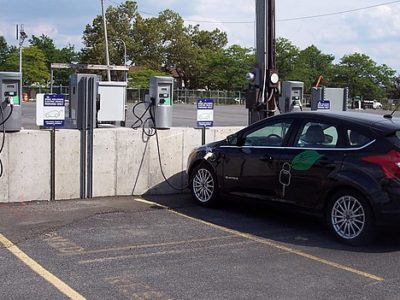Four EV Trends
Legal Planet: Environmental Law and Policy 2023-11-20

The automotive world is changing quickly. Most of the trends are mutually reinforcing. But one points in the opposite direction.
The first and most obvious trend is the rise of EVs. In the twenty years since Tesla arrived, EVs have gone from 0.2% of new cars to 13%, and Bloomberg predicts that this figure will nearly double in the next few years. According to the Economist, by 2040 about three-quarters of global sales will be EV even under conservative assumptions. The industry certainly thinks this trend is real, with investments expected to total over a trillion dollars by 2030, and established companies like GM, Ford, and VW firmly on board.
The second trend is technological. Internal combustion engines have seen significant, though incremental, technological improvements, which have been driven by tougher emission standards and fuel economy rules. But EV batteries are a new technology, with much more room for development. In the decade from 2011 to 2021, the average EV range went from 86 miles to 217 miles. Solid state batteries could do much better. Toyota claims to have a new battery with a range of 746 miles that can be recharged in ten minutes. Bringing new technologies to scale can be difficult, but there’s clearly a lot of headroom in terms of battery performance.
A third trend involves political economy. The EV industry is growing rapidly, creating new jobs. Much of the growth is happening in Southern states with warm support from Republican governors. According to the NY Times, the industry’s growth has caused “billions of dollars to pour into states like Michigan and Ohio, but also to Georgia, South Carolina, Alabama and Tennessee, to assemble electric vehicles and build batteries and other parts with the warm embrace of Republican governors.” BY 2031, according to the Bureau of Labor Statistics, the EV transition will produce eight million new jobs.
The final trend is ideological. Republicans are devoting increasing firepower to attacking EV subsidies and tougher regulations for gas and diesel vehicles, seeking to delay the transition to EVs. No doubt their allies in the oil industry are rewarding them for this trend. Ron DeSantis has made the defense of gas-guzzlers his personal Alamo: “we will eliminate subsidies for EVs, and we will support Americans’ right to drive the cars they want. We will save the traditional American automobile.” Trump, too, is at war with EVs, accusing them of destroying the car industry and saying rather weirdly that they run out of power in fifteen minutes.
Although you can never rule out the possibility of surprises, a global transition to EVs seems all but inevitable. The question is whether conservative ideologues and their fossil fuel allies will succeed in slowing down the movement. The longer the incentives in the Inflation Reduction Act are in effect, the harder it will be to ditch them. Even now, there must be considerable pressure on congressional Republicans to protect the investment being made in their districts. If the Democrats can hold onto the presidency or the House another few years, repeal may become all but impossible.
In the meantime, it remains to be seen whether tough new vehicle standards will be knocked down by the Supreme Court or by a new Republican president. Slowing the EV transition would carry a heavy environmental cost. The long-term trend is good news, but moving at speed is also important, given the urgency of cutting carbon emissions.